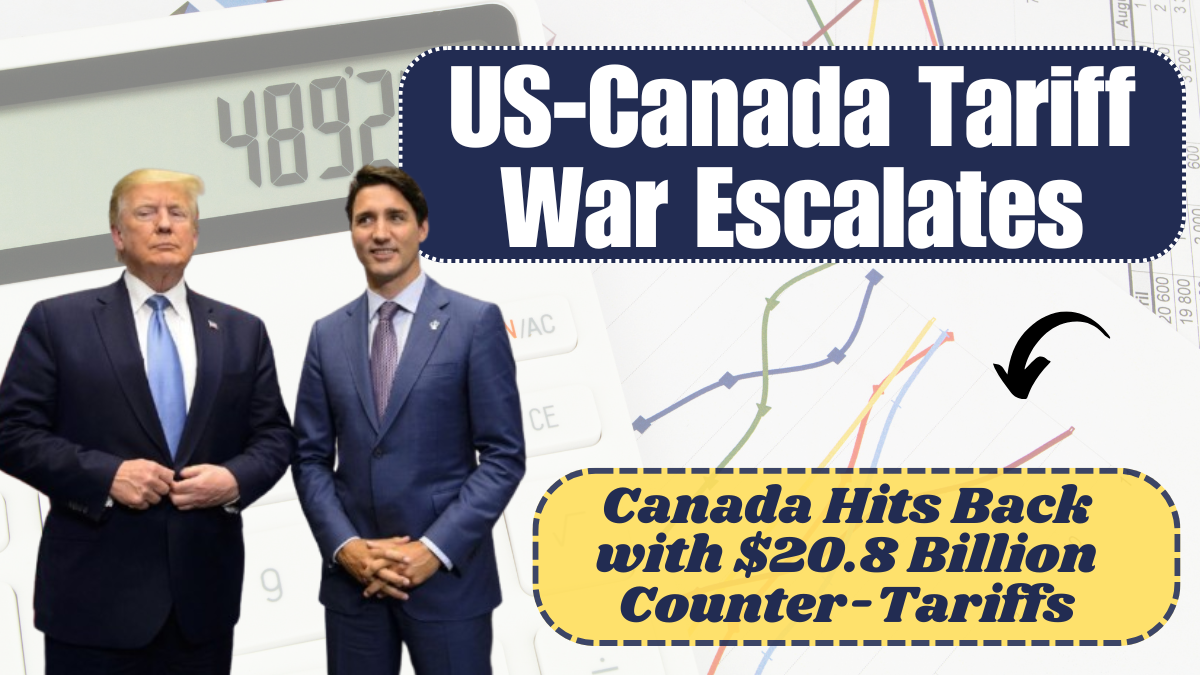The US-Canada trade relationship has taken a sharp downturn after President Donald Trump raised tariffs on Canadian steel and aluminum imports, triggering a strong response from Ottawa. In retaliation, Canada is rolling out counter-tariffs worth $20.8 billion (C$30 billion), affecting a wide range of American-made products, with the automotive sector likely to feel the heat.

What Sparked the Tariff Battle in April 2025?
Tensions escalated after Ontario, Canada’s most populous province, imposed a regional energy tax on fuel and electricity exports to the United States. The Trump administration responded swiftly by increasing duties on Canadian metal imports, citing the move as “unfair and hostile.”
On his Truth Social account, Trump stated:
“I have directed my Secretary of Commerce to impose an additional 25%, up to 50%, on all steel and aluminum entering the United States from Canada—one of the highest tariffing nations in the world.”
The new US tariffs took effect on March 12, 2025, sparking outrage in Canadian political and business circles.
Canada’s Retaliatory Tariff Plan – What We Know
Canada’s Ministry of Finance has drafted a list of American goods facing immediate tariffs, which include sectors like:
-
Automobiles and car parts
-
Processed food and beverages
-
Household appliances
-
Building materials (e.g., glass, ceramics)
-
Consumer electronics
Key figures:
| Category | Estimated Tariff Impact |
|---|---|
| Auto & Auto Components | $6.5 billion |
| Food and Agricultural Products | $3.8 billion |
| Industrial Machinery | $2.4 billion |
| Electronics and Appliances | $4.1 billion |
| Miscellaneous Consumer Goods | $4.0 billion |
These countermeasures are scheduled to begin rolling out from April 15, 2025, unless an agreement is reached beforehand.
Potential Impact on Canadian Industries
While the counter-tariffs are meant to apply pressure on the US, experts warn that Canadian businesses, especially automobile manufacturers dependent on U.S. parts, may also face economic fallout. Consumer prices are expected to rise in certain sectors, particularly:
-
Imported food brands
-
Car parts and servicing costs
-
Construction and home appliances
Canadian businesses are urging the federal government to offer temporary relief or subsidies for industries affected by retaliatory costs.
Trump’s Broader Trade Agenda
President Trump’s second term has seen an aggressive return to protectionist policies. Since resuming office, he has:
-
Raised tariffs on steel and aluminum from Canada, China, and Mexico
-
Threatened fresh tariffs set to begin April 2, 2025
-
Reintroduced talks of removing trade exemptions for certain regional partners
Trump maintains that such measures are aimed at bringing manufacturing jobs back to the US and reducing trade deficits.
Will Canada and the US Reach a Settlement?
So far, diplomatic efforts between Ottawa and Washington have failed to yield a breakthrough. Canadian Prime Minister Justin Trudeau has called the tariffs “unjust and economically harmful to both countries,” and hinted at potential World Trade Organization (WTO) arbitration if talks collapse.
Trade analysts believe both sides may enter a negotiation window in late April, especially as domestic pressure mounts in both countries due to supply chain disruptions and inflation.
FAQs
What are the US tariffs that triggered Canada’s retaliation?
President Trump imposed 25% to 50% tariffs on Canadian steel and aluminum exports following Ontario’s new energy tax affecting US imports.
What is the value of Canada’s counter-tariffs?
Canada has announced $20.8 billion (C$30 billion) worth of counter-tariffs targeting American goods starting April 15, 2025.
Which industries are most affected?
Automobiles, processed foods, consumer electronics, industrial machinery, and home appliances are among the most impacted sectors.
When will Canada’s counter-tariffs come into effect?
The tariffs are scheduled to begin mid-April 2025, unless trade negotiations bring about a reversal or compromise.
How will this affect Canadian consumers?
Prices of certain imported American goods may rise, especially in automotive parts, electronics, and groceries.
Is there any chance of a trade agreement?
While both countries remain at odds, diplomatic channels are still open, and negotiations are likely to resume later in April 2025.
Click here to know more.
